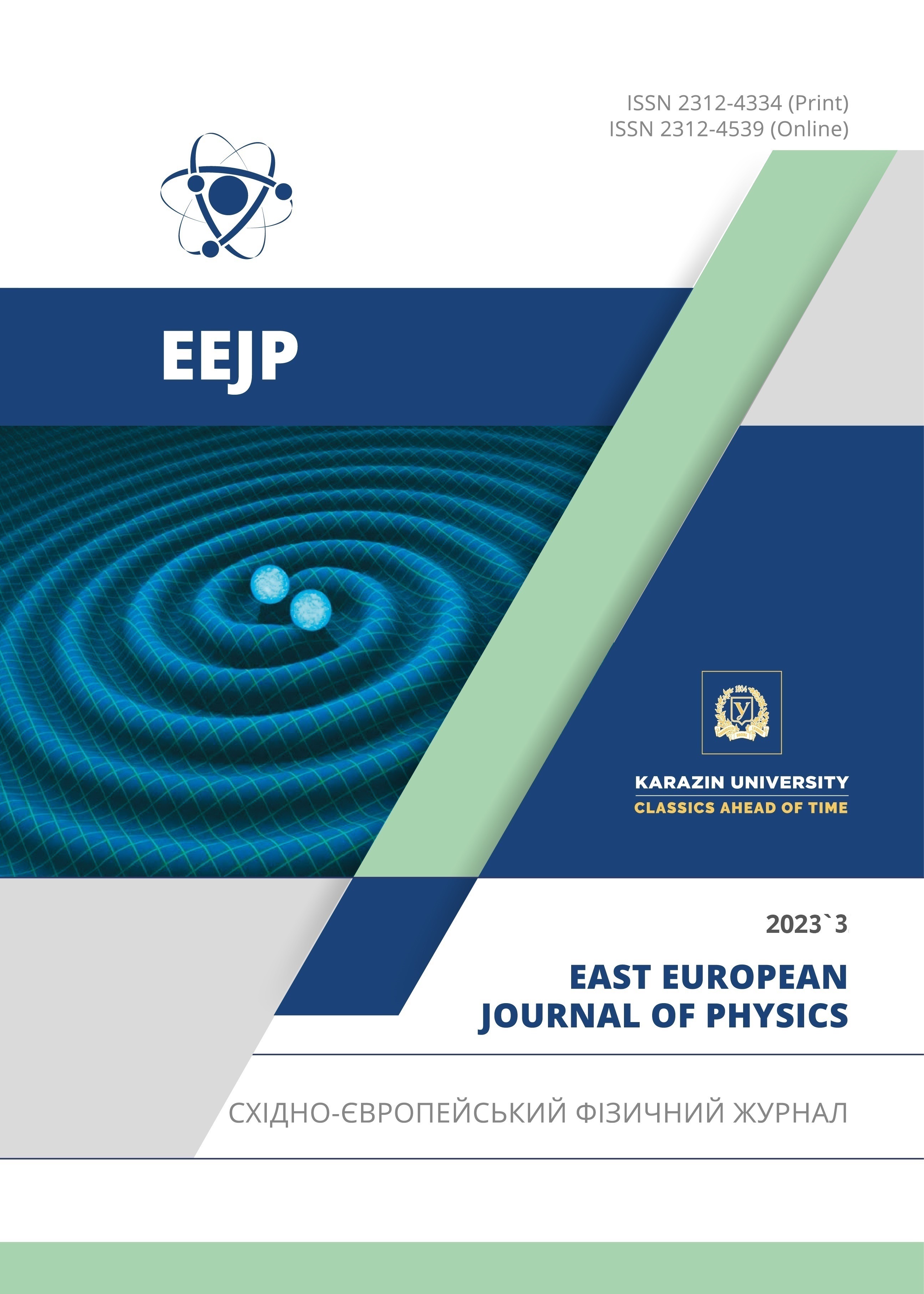Amplitudes of 3H, 3He Two-Particle Photo-Breakup in Non-Local QED Approach
Abstract
Three-nucleon systems are essential for the investigation of many-body forces in nuclear physics. Well-grounded parametrization of their vertex functions with further application for the calculation of cross-sections in nonlocal QED approach provides the ground for investigation of the variety of multi-particle systems. In present paper we describe the process of parametrization of two-particle photo-breakup amplitudes of three-nucleon systems (3H, 3He). We provide the general description of the wave function construction for three-nucleon systems as well as the parametrization of their vertex functions accounting two- and three-nucleon interactions based on meson exchange current formalism. In our calculations we account first and second order one-pion exchange terms and the term related to the exchange of ω and ρ mesons. The three-nucleon interaction potential is given as a sum of attraction (two-pion exchange) term and
appropriate repulsive part. Based on the variational ”Urbana + Model VII” amplitudes we provide the results for energy dependence of differential cross-section of 3He(γ, p)d reaction at proton angle θ = 90◦ from the threshold up to Eγ = 40 MeV and compare theoretical predictions with the available experimental data. The investigation is also provided for angular cross-section distributions at high photon energies (Eγ = 305 ± 5 MeV; 365 ± 5 MeV; 450 ± 10 MeV and 675 ± 50 MeV). Correct description of 3H, 3He photo-disintegration processes in a unified approach based on the gauge nature of the electromagnetic field implies application of this model for other multi-particle systems.
Downloads
References
G.E. Brown, A.M. Green, ”Three-body forces in nuclear matter,” Nuclear Physics A, 137(1), 1-19 (1969). https://doi.org/10.1016/0375-9474(69)90068-2
G. Derrick, D. Mustard, and J.M. Blatt, ”Binding energy of the triton,” Phys. Rev. Lett. 6, 69 (1961). https://doi.org/10.1103/PhysRevLett.6.69
H. Wita, J. Golak, R. Skibiski, K. Topolnicki, and V. Urbanevych, ”Investigation of the interaction of circularly and linearly polarized photon beams with a polarized 3He target,” Phys. Rev. C, 101, 2 (2020). https://doi.org/10.1103/PhysRevC.101.024003
R. Schiavilla, V.R. Pandharipande, and R.B. Wiringa, ”Momentum distributions in A=3 and 4 nuclei,” Nuclear Physics A, (449)(2), 219-242 (1986). https://doi.org/10.1016/0375-9474(86)90003-5.
W.W. Buck, and F. Gross, ”Family of relativistic deuteron wave functions,” Phys. Rev. D20(9), 2361-2379 (1979). https://doi.org/10.1103/PhysRevD.20.2361.
H. Wita, J. Golak, R. Skibiski, K. Topolnicki, and V. Urbanevych, ”Investigation of the interaction of circularly and linearly polarized photon beams with a polarized 3He target,” Phys. Rev. C, 101, 2 (2020). https://doi.org/10.1103/PhysRevC.101.024003
I.E. Lagaris, V.R. Pandharipande, ”Phenomenological two-nucleon interaction operator,” Nuclear Physics A, 359, 331-348 (1981). https://doi.org/10.1016/0375-9474(81)90240-2
Y.A. Kasatkin, V.P. Klepikov, P.E. Kuznietsov, ”Two-particle photodisintegration of the 3He and 3H nuclei in a relativistic approach with a strictly conserved EM current,” Phys. Part. Nuclei Lett. 12, 481–493 (2015). https://doi.org/10.1134/S1547477115040172
G. Laskaris, W. Ji, et al.,”First measurement of the asymmetry and the Gerasimov-Drell-Hearn integrand from the 3He(γ, p)2H reaction at an incident photon energy of 29 MeV,” Phys. Rev. C, 103, 3 (2021). https://doi.org/10.1103/PhysRevC.103.034311
Yu.A. Kasatkin, V.F. Klepikov, and P.E. Kuznietsov, ”Two-particle photodisintegration of light nuclei with conserved EM current,” Problems of Atomic Science and Technology, 93(5), 18–25 (2014). https://vant.kipt.kharkov.ua/ARTICLE/VANT_2014_5/article_2014_5_18.pdf
P.E. Kuznietsov, ”Unified Description of Photo and Electro Processes on Light Nuclei in Covariant Approach with Exactly Conserved EM Current,” East European Journal of Physics, 2(1), 88-92 (2015). https://doi.org/10.26565/2312-4334-2015-1-13
W. Schadow, O. Nohadani, and W. Sandhas, ”Photonuclear reactions of three-nucleon systems,” Phys. Rev. C, 63, 044006 (2000). https://doi.org/10.1103/PhysRevC.63.044006.
M. Karlsson, et al. ”Measurement of the differential cross section for the two-body photodisintegration of 3He at θLAB = 90◦ using tagged photons in the energy range 14 − 31 MeV,” Phys. Rev. C, 80, 4 (2009). https://doi.org/10.1103/PhysRevC.80.044001
J.R. Stewart, R.C. Morrison, and J.S. O’Connell, ”Photodisintegration of He3,” Phys. Rev. 138, 2B (1965). https://doi.org/10.1103/PhysRev.138.B372
V. Isbert, G. Audit, N. d’Hose, et al., ”Two body photodisintegration of 3He between 200 and 800 MeV / // Nucl. Phys. A, 578, 525-541 (1994). https://doi.org/10.1016/0375-9474(94)90759-5.
J. Golak, H. Wita la, R. Skibi´nski, K. Topolnicki, Y. Volkotrub, A. Grassi, V. Soloviov, V. Urbanevych, ”Theoretical investigations of three-nucleon systems,” Acta Physica Polonica. B, Proceedings Supplement, 13(4), 609–618 (2020). https://doi.org/10.5506/APhysPolBSupp.13.609
Copyright (c) 2023 Pylyp Kuznietsov, Yuriy A. Kasatkin, Vyacheslav F. Klepikov

This work is licensed under a Creative Commons Attribution 4.0 International License.
Authors who publish with this journal agree to the following terms:
- Authors retain copyright and grant the journal right of first publication with the work simultaneously licensed under a Creative Commons Attribution License that allows others to share the work with an acknowledgment of the work's authorship and initial publication in this journal.
- Authors are able to enter into separate, additional contractual arrangements for the non-exclusive distribution of the journal's published version of the work (e.g., post it to an institutional repository or publish it in a book), with an acknowledgment of its initial publication in this journal.
- Authors are permitted and encouraged to post their work online (e.g., in institutional repositories or on their website) prior to and during the submission process, as it can lead to productive exchanges, as well as earlier and greater citation of published work (See The Effect of Open Access).








